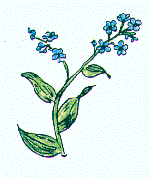|
Forget-Me-Not


 The Forget-Me-Not, an age-old symbol of friendship and love, is a member
of the Borage Family. (Borage means "rough haired" or "woolly"). Its
generic name is Myosotis, a combination of two Greek words
for mouse and ear, from the short and soft leaves in some
species. Since many forget-me-nots' leaves are pubescent or hairy, it is
not hard to understand why they are so called. A little more mystifying is
the name "scorpion grass", which is applied to one species. It was an
ancient English belief that the user of this forget-me-not would not have
to be afraid of scorpions. How were the ancients to know that this was
because there are no scorpions in England? The name "scorpion grass" also
could have been given because of the characteristic of the unopened flower
clusters of the forget-me-not to be curled up much like a scorpion's tail.
Interesting too, is the fact that the color of the forget-me-not, blue with
yellow centers, led scientists to the discovery that bees recognize color,
and that the color markings of many flowers serve as pathways to the nectar.
The Forget-Me-Not, an age-old symbol of friendship and love, is a member
of the Borage Family. (Borage means "rough haired" or "woolly"). Its
generic name is Myosotis, a combination of two Greek words
for mouse and ear, from the short and soft leaves in some
species. Since many forget-me-nots' leaves are pubescent or hairy, it is
not hard to understand why they are so called. A little more mystifying is
the name "scorpion grass", which is applied to one species. It was an
ancient English belief that the user of this forget-me-not would not have
to be afraid of scorpions. How were the ancients to know that this was
because there are no scorpions in England? The name "scorpion grass" also
could have been given because of the characteristic of the unopened flower
clusters of the forget-me-not to be curled up much like a scorpion's tail.
Interesting too, is the fact that the color of the forget-me-not, blue with
yellow centers, led scientists to the discovery that bees recognize color,
and that the color markings of many flowers serve as pathways to the nectar.

 The true forget-me-not is known as Myosotis scorpicides. The
corolla of the flower is sky blue with a yellow center, and is a fourth of
an inch to a third of an inch across. The calyx lobes are short and hairy.
The leaves are one to three inches long, and also are rough and hairy,
rooting at the lower nodes. The plant, first introduced from Europe by the
Pilgrims, has escaped from cultivation. It does well in wet or damp places.
Utahns may be more familiar with Myosotis arvensis (also from
Europe), which grows along mountain roadsides in dry, sandy areas.
The true forget-me-not is known as Myosotis scorpicides. The
corolla of the flower is sky blue with a yellow center, and is a fourth of
an inch to a third of an inch across. The calyx lobes are short and hairy.
The leaves are one to three inches long, and also are rough and hairy,
rooting at the lower nodes. The plant, first introduced from Europe by the
Pilgrims, has escaped from cultivation. It does well in wet or damp places.
Utahns may be more familiar with Myosotis arvensis (also from
Europe), which grows along mountain roadsides in dry, sandy areas.
 Myosotis scorpicides has many relatives in the intermountain
region. Among them are:
Myosotis scorpicides has many relatives in the intermountain
region. Among them are:
 Cryptantha nana
Cryptantha nana
 -- six inches high with white, yellow centered flowers.
-- six inches high with white, yellow centered flowers.
 Cynoglossum officinales
Cynoglossum officinales
 Hound's Tongue, also introduced from Europe
Hound's Tongue, also introduced from Europe
 -- two feet tall with dark maroon red flowers.
-- two feet tall with dark maroon red flowers.
 Hackelia patens
Hackelia patens
 Stickseed
Stickseed
 Mertensia ciliata and Mertensia oblongifolia
Mertensia ciliata and Mertensia oblongifolia
 Mountain Bluebells
Mountain Bluebells
 -- with nodding bell-like flowers of pink and blue.
-- with nodding bell-like flowers of pink and blue.
 Lithospermum incisum and Lithospermum ruderale
Lithospermum incisum and Lithospermum ruderale
 Puccoon
Puccoon
 -- with flowers that are cream to yellow.
-- with flowers that are cream to yellow.
 -- by Adrianne Montgomery
-- by Adrianne Montgomery
|
|
